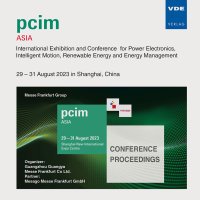Gate oxide degradation of SiC IGBT induced by non-constant thermal-electrical coupled stresses
Conference: PCIM Asia 2023 - International Exhibition and Conference for Power Electronics, Intelligent Motion, Renewable Energy and Energy Management
08/29/2023 - 08/31/2023 at Shanghai, China
doi:10.30420/566131016
Proceedings: PCIM Asia 2023
Pages: 6Language: englishTyp: PDF
Authors:
Luo, Rongde; Wu, Fugen (State Key Laboratory of Precision Electronic Manufacturing Technology and Equipment, Guangdong University of Technology, Guangzhou, China & School of Materials and Energy, Guangdong University of Technology, Guangzhou, China)
Yang, Shaodong; Luo, Xia; Niu, Hao; Kuang, Xianjun; Dai, Zongbei (No.5 Electronics Research Institute of the Ministry of Industry and Information Technology, Guangzhou, China)
Xu, Xiaowei (Three Gorges Intelligent Industrial Control Technology Company, Wuhan, China)
Dong, Huafeng (School of Physics and Optoelectronic Engineering, Guangdong University of Technology, Guangzhou, China)
Abstract:
The SiC/SiO2 interface property has become a non-negligible reliability risk for SiC power electronic devices. The degradation mechanism of the SiC/SiO2 interface of SiC IGBTs under non-constant thermal-electrical coupled stresses was investigated in this study, based on variation analysis of sensitive static characteristics. Under positive bias (Group 2: +70 V, Group 3: +50 V) at 150 ℃ for 675 h, VGE(TH) increased slightly. Then a mild rebound happened to Groups 2 and 3 after 15 days of recovery (Stage 2: under 25 ºC / 50 %RH). Afterwards, a significant decrease of VGE(TH) within 48 h under negative bias (Group 2: -70 V, Group 3: -50 V), probably due to the holes captured by traps rapidly at or near the SiC/SiO2 interface. The harsher stresses led to more serious VGE(TH) drift as expected. While no significant VGE(TH) fluctuations were observed after HTSS tests (at 150 ºC). Besides, the IGES and V(BR)CES did not change significantly, which indicates there is no permanent damage.


